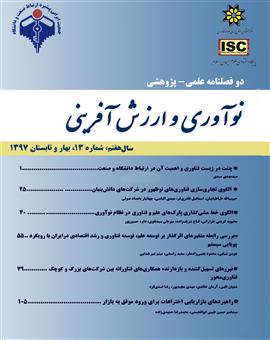پتنت در زیست فناوری و اهمیت آن در ارتباط دانشگاه و صنعت
محورهای موضوعی : عمومی
1 - پژوهشگاه ملی مهندسی ژنتیک و زیست فناوری ،ایران
کلید واژه: پتنت, زیست فناوری, نوآوری, ارتباط دانشگاه و صنعت, کارآفرینی,
چکیده مقاله :
یکی از اهداف اصلی شرکت های زیست فناوری پیشتازی در بازار بواسطه داشتن فرآورده ها و یا فرآیندهای جدید به منظور دست یافتن به نفوذ بالا در بازار، اطمینان از آزادی عمل و ممانعت از ورود رقبا میباشد. بطور کلی بازار زیست فناوری به دو بخش عمده تقسیم می شود: گروه اول شرکت ها یا موسساتی هستند که ابزار و یا فناوری ها را ابداع می کنند و گروه دوم شرکت هایی هستند که دست به تولید و تجاری سازی فرآورده هایی می زنند که از این ابزار و فناوری ها بهره برده اند. یکی از موانع اصلی موفقیت شرکت ها ویا مؤسسات زیست فناوری به قابلیت آنها در انتقال حق مالکیت فکری با بهای مناسب میباشد. ولی مجوز دادن به نوآوری های زیست فناورانه کاری پیچیده و چند رشته ای است.به بخشهای مختلف با تخصص های گوناگون به منظور تعامل با دیگر بخش ها در سطوح پیچیده ، به طور همزمان برای سود آوری متقابل نیاز است. بازار زیست فناوری به کسانی که ابزارها و فناوری ها را تولید میکنند و کسانی که که با استفاده از این ابزارها و فناوری ها محصولات تجاری را بسط میدهند تقسیم بندی میشوند. پتنت های زیست فناوری در توانا ساختن شرکت ها جهت گسترش پیدا کردن، برای مثال، فرآورده های مرتبط با زندگی نقش مهمی را ایفا می کنند که به علت این است که حقوق مالکیت فکری که توسط پتنت برای مدت زمانی محدود اعطا می شود، فرصتی را برای احیاء سرمایه گذاری انجام شده برای بسط دادن اختراع ثبت شده، روانه کردن فرآورده های جدید به بازار، یا مجوز دادن ویا انتقال حقوق گفته شده به شرکت های دیگر فراهم می کند. بنابراین، استفاده از حقوق مالکیت فکری، به ویژه پتنت ها، برای ایجاد فرصت های جدید در بازار، ایجاد انگیزه برای نوآوری لازم است. از سوی دیگر، حفاظت ناکافی از مالکیت فکری و مدیرت ناکارآمد آن، برخی از موانع عمده بر سر راه تجاری سازی در بخش زیست فناوری هستند.
This paper explores several characteristics of patents in the biotechnology field, comparing and contrasting them to patents in other fields of research. We find that biotechnology patents face a longer lag between application and grant date, and their secrecy would be heavily affected if legislation were to permit publication 18 months after application. They are highly concentrated geographically, as well as in industrial origin, and are used most heavily in the health sector, but have a wider spread in use than in origin. They use many more (and much more recent) references than the average patent, with a special weight on academic or scientific literature, foreign patents, and a tight circle of research fields. While they are not cited frequently on average, their use as germplasm is rising. Future research should focus on the questions that have been uncovered
Arundel A, Sawaya D. (2007). The Role of Biotechnology Intellectual Property Rights in the Bioeconomy of 2030. OECD International Futures Programme. Paris
Baker D, Jayadev A, Stiglit J. (2017) Innovation, Intellectual Property, and Development. Available at: accessibsa. org.
Biotechnology Comparative Study on Biotechnology Patent Practices. Comparative Study Report. Available at: http://www.trilateral.net/projects/biotechnology/practices.pdf (Accessed on Nov 2011
Butcher S. (2009). Stimulating the Life Science Industry. Available at: http://www.areadevelopment.com/Biotech/bio09/stimulating-life-sciences007.shtml?Page=2, accessed 25.11.2013.
Ernst &Young (2013). Beyond Borders: Matters of Evidence. Biotechnology Industry Report 2013. Available at: http://www.ey.com/Publication/ vwLUAssets/Beyond_borders/$FILE/Beyond_borders.pdf, accessed 10.10.2013.
European Federation of Biotechnology, BIOTEC, Europe 6; 96.
European Commission (2012). Innovating for Sustainable Growth: A Bioeconomy in Europe, Brussels: European Commission.
European Patent Convention. 14th ed. Published by European Patent Office in Germany. August 2010.
García AM, López-Moya JR, Ramos P (2013). Key Points in Biotechnological Patents to be Exploited. Recent Patents on Biotechnology 7, 84-97.
Gokhberg L., Fursov K., Miles I., Perani G. (2013). Developing and using indicators of emerging and enabling technologies. Handbook of Innovation Indicators and Measurement (ed. F. Gault), Cheltenham: Edward Elgar Publishing Limited.
Katila R and Mang PY. (2003). Exploiting technological opportunities: The timing of collaborations. Research Policy 2003; 32: 317-332.
Khan R. (2014). Quantitative research method – Phenomenology. Asian Social Science. 10: 298-310.
National Science Foundation. Annual report. 2017 North American Industry Classification System (2018). Available at: http://www.NAICS.com/Publication/
OECD (2017). Key Biotechnology Indicators, Available at: ww.oecd.org/sti/ biotechnology/indicators. May 2017.
OECD International Futures Project on “The Bioeconomy to 2030: Designing a Policy Agenda” Dec 2007.
Radit J. (2014) Patents and Biotechnology, U.S. Chamber of Commerce Foundation.
Rao R. (2012). Patenting in Biotechnology — An Overview (SSRN Working Paper Series). Available at: http://papers.ssrn.com/sol3/papers.cfm?abstract_id=1999541, accessed 01.12.2013.
Rudolph J.R. (1996). A Study of Issues Relating to the Patentability of Biotechnological Subject Matter , Toronto: Gowling, Strathy & Henderson.
Singh, K. (2015). Biotechnology and Intellectual Property Rights, Legal and Social Implications. Springer ISBN 978-81-322-2058-9.
Thomas J. (2012). Implications for Patents, Biotechnology, and Personalized Medicine. CRS Report for Congress. Available at: http://www.fas.org/sgp/crs/misc/R42815.pdf, accessed 01.12.2012.
WIPO (2017). World Intellectual Property Indicators 2017. Geneva: World Intellectual Property Organization.


